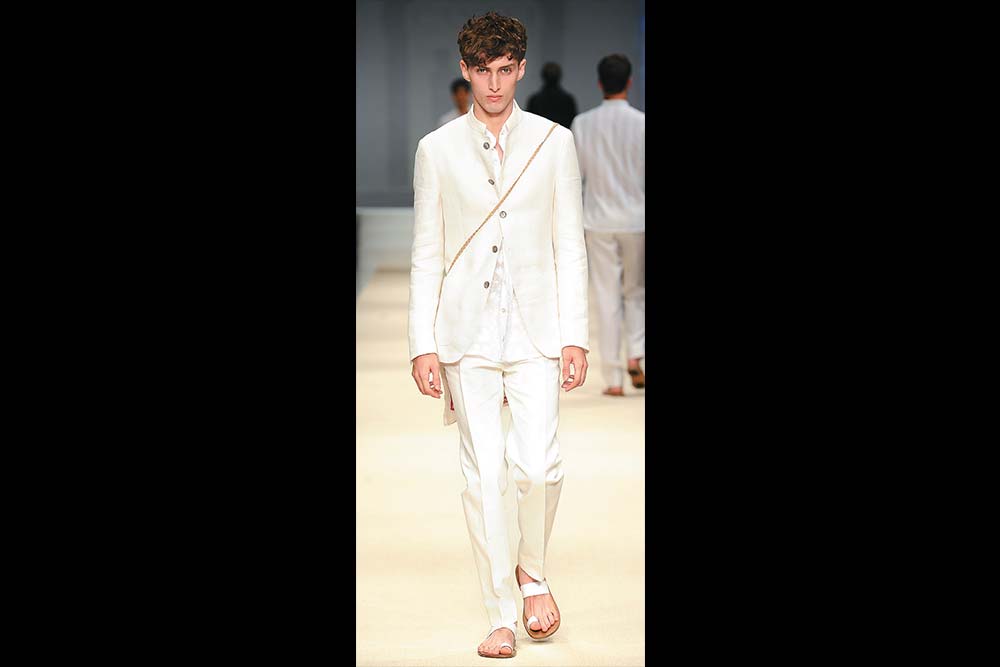The first time I tried on Canali’s Nawab bandhgala at ITC Maurya in New Delhi with a little help from Paolo Canali himself, I remember feeling churlish about it. Perhaps it had to do with national pride. Why was an Italian company doing what an Indian brand should have done in the first place?
Men in India have a strange relationship with the bandhgala—or the Jodhpur coat as some call what, at one time, was also referred to as the prince coat. Most will say they prefer it to the two- or three-button Western jacket, yet you won’t see them wear one in the office. That’s because they’re to blame for having exotic-ised it and relegated it to a minor role in the Indian wedding where it is the preferred choice for young men who prefer hanging out around the bar.
Yet, as a formal garment, it is unbeatable, and no one understands this better than Raghavendra Rathore who has made a statement with his bandhgalas ever since he launched his brand. If you’ve seen Rathore wear a bandhgala, you’ll understand why. The jacket is structured in a manner that stylists deem ‘slim-fit’ and what in the West is referred to as silhouette: the construction emphasises broad shoulders and a narrow waist, even if your body type is the opposite.
I admire his bandhgalas but, for years, I’ve been getting mine from a small outfit in Jaipur called Jodhpur Tailors. Jugal Chauhan at Jodhpur Tailors doesn’t give a hoot about fashion in the big cities nor will he concede to the passing fads of the season. Once, fearing I might be putting on weight, I asked Jugal Bhaisa’ab to make the bandhgala roomier at the waist. “Get it stitched in Delhi,” he said.
At Jodhpur Tailors, the silhouette is, if anything, sharper even than Rathore’s. When he puts in a creased vent at the back in his corduroy bandhgalas with their elbow patches—a style that’s difficult to achieve at most times—you can expect him to build a longer flap at the back. I asked him if he would give me similar flaps on the side instead of the back and lengthen the bandhgala, and Jugal Bhaisa’ab’s answer was: “Get it done in Delhi.”
I have had bandhgalas done in Delhi, if only because it’s more convenient. There was a time when Delhi’s tailors prided themselves on fitting Presidents in achkans, but there’s almost no one now who can give you a classic fit. No matter how much you ask, they end up looking—tubby. Perhaps it’s got too used to dressing politicians.
Nonetheless, you will find bandhgalas off the rack. Nine Styles (in New Delhi and Guwahati) does a hybrid Jodhpur coat, which is not really a bandhgala (it doesn’t have a collar) though it might meet the needs of the trendy baraati in a hurry. I like the fabric but the style with its piped edgings leaves me hoping that other contemporary adaptations will be less drastic.
I tried Louis Philippe’s bandhgala version, which is definitely more wearable for someone my age. I wasn’t partial to its concealed buttons, but it was the sizes that didn’t work at all. I hope Louis Philippe won’t cancel my gold card for saying they need more flexibility in sizing if they want to make as much of a success with their blazer-bandhgalas as with their Oxford suits.
I haven’t had a chance to go to Wills Lifestyle this winter, but last year they had a number of inspired bandhgalas, and there was one by JJ Valaya that I particularly liked because it had the designer’s fine eye for detail, but mostly because of its structured construction. Even the sizing was right, though I must confess I tend to buy from Wills only when they have a sale on.
Taken into consideration, it’s evident that the construction of the bandhgala is critical. Does Canali crack it? When it comes to tailoring you can’t beat the Italians. When I tried the Canali, I knew they had got the style right. Canali explained the role of something that he called placket that gave the garment its firm shape. I liked the fit well enough, but at Rs 96,000 for the suit (Rs 69,000 for just the coat), it is more than a tad expensive as office-wear. And yet, it’s doing well: over a hundred pieces sold in the first month of its introduction in Delhi, so it’s clear that men are willing to pay the price if the fit is good.
And yet, I know I’m reconciled to going to Jodhpur Tailors because nothing comes as close in style—even if it means that the request for an appointment last month has been accommodated only in February. You can’t hurry bespoke, even if it is a hole-in-the-wall in Jaipur rather than the rarefied salons of Delhi.
—The author is a delhi-basedwriter and curator











